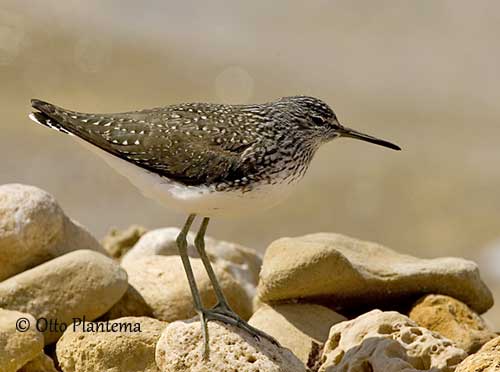Fr: Chevalier culblanc
Ang: Green Sandpiper
All: Waldwasserläufer
Esp: Andarríos Grande
Ita: Piro piro culbianco
Nd: Witgat
Sd: skogssnäppa
Photographers:
John Anderson
John Anderson Photo Galleries
Steve Garvie
RAINBIRDER Photo galleries & Flickr Rainbirder
Otto Plantema
Trips around the world
Text by Nicole Bouglouan
Sources:
HANDBOOK OF THE BIRDS OF THE WORLD Vol 3 by Josep del Hoyo-Andrew Elliott-Jordi Sargatal - Lynx Edicions - ISBN : 8487334202
SHOREBIRDS by Peter Hayman, John Marchant and Tony Prater – Christopher Helm – 1986 – ISBN: 0747014035
THE HANDBOOK OF BIRD IDENTIFICATION FOR EUROPE AND THE WESTERN PALEARCTIC by Mark Beaman, Steve Madge - C. Helm - ISBN: 0713639601
GUIDE DES LIMICOLES de D. Taylor - Delachaux et Niestlé - ISBN : 2603014080
ENCYCLOPEDIE DES OISEAUX DE FRANCE ET D’EUROPE – de Peter Hayman et Rob Hume - Flammarion – ISBN : 2082009920
THE COMPLETE BOOK OF BRITISH BIRDS – Written by “Royal Society for the Protection of Birds” experts - Préface de Magnus Magnusson - Michael Cady- Rob Hume Editors - ISBN: 0749509112
BIRDS OF THE MIDDLE EAST by R.F. Porter, S. Christensen, P Schiermacker-Ansen C.Helm - ISBN: 0713670169
BIRDS OF AFRICA SOUTH OF THE SAHARA by Ian Sinclair and Peter Ryan - Princeton University Press Princeton and Oxford - ISBN: 0691118159
What Bird-The ultimate Bird Guide (Mitchell Waite)
Birdwatch – The Home of Birding
Wikipedia, the free encyclopaedia
Green Sandpiper
Tringa ochropus
Charadriiformes Order – Scolopacidae Family
INTRODUCTION:
The Green Sandpiper is a fairly bulky, small wader that looks very dark above and white below. It is typically found by inland fresh waters. Unlike most Scolopacidae, it usually nests in trees, but instead of building a nest, it uses an old one, abandoned by other species, especially thrushes and Wood Pigeon. However, it may occasionally nest on the ground among tree roots.
The Green Sandpiper breeds in forested habitats across N Europe and Asia, and spends the winter from Africa to SE Asia.
This species is currently not globally threatened, in spite of some decline due to habitat changes in wintering areas.
DESCRIPTION OF THE BIRD:
Biometrics:
Length: 21-24 cm
Wingspan: 57-61 cm
Weight: 71 g (53-119 g)
The Green Sandpiper adult in breeding plumage has almost blackish and white appearance. On the upperparts, mantle and wing-coverts are very dark, olive-brown with small buffy-white spots. These spots are larger on scapulars and tertials. Rump and tail are white, with broad, black bars on the tail. Crown and hindneck are whitish, with heavy dark brown streaking.
On the underparts, chin, throat and breast are whitish with intense dark brown streaking, merging into irregular blotches on breast and upper flanks. On the underwing, coverts and axillaries are blackish-brown, narrowly barred with white. Rest of underparts is white.
On the head, we can see a conspicuous white supercilium in front of the eye, and a narrow white eyering. There is a very dark line across the lores, but it does not extend behind the eye.
The straight bill has olive-green base and blackish tip. The eyes are dark brown. Legs and feet are dull greyish-green, but they look dark at a distance.
Male and female are similar, but the female is slightly larger than male.
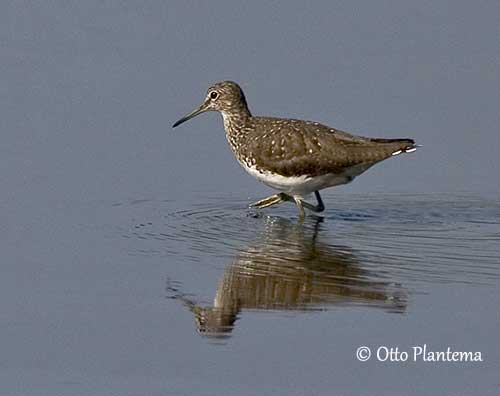
The non-breeding adult has paler, more greyish-brown head and breast, with slightly darker streaking. Scapulars and tertials show smaller pale spots.
The juvenile resembles non-breeding adult, but it has browner upperparts and breast, with small buff spots on scapulars and tertials. The breast is more uniformly coloured and lacks the irregular spotting.
RANGE:
The Green Sandpiper breeds in Scandinavia and N and E Europe, through C Asia and E Siberia, with isolated population in Kyrgyzstan (C Asia) and extreme NW China (NW Xinjiang).
It winters in Mediterranean and tropical Africa, and from Turkey through Middle-East and Indian Subcontinent to S japan, E China, Philippines and N Borneo. There are small populations wintering in W and WC Europe, and in Tien Shan area.
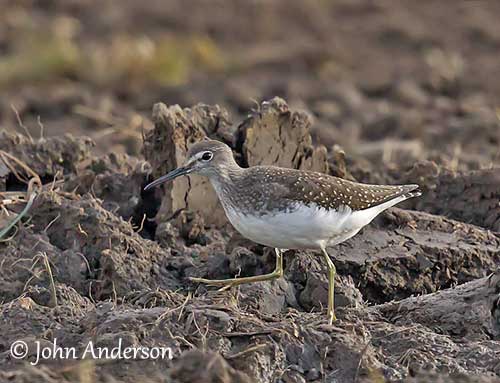
HABITAT:
The Green Sandpiper breeds in damp area in various types of woodlands including swampy woodland, montane forest (pine, spruce and alder), usually close to water, in vicinity of rivers and streams, swamps and lakes.
On the wintering grounds, it can be found in freshwater locations, by streams, pools, ditches, sewage farms, marshes, and occasionally, sheltered tidal creeks.
This species is recorded at high elevation in winter, more than 2700 metres in Ethiopia, 2800 metres in Bhutan, and more than 3000 metres in Turkey.
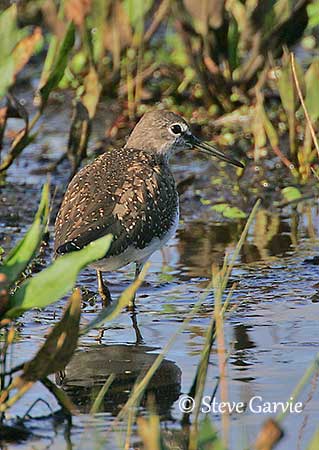
CALLS AND SONGS: SOUNDS BY XENO-CANTO
The Green Sandpiper’s usual call is a high-pitched “twit-wit-wit” sometimes preceded by a rising “ko-wit”. These calls can be heard when the birds are flying at great height during the migration. During the breeding season, the alarm call is a rapid “tit-ti-tit”.
The song is a medley based on variations of call notes, a loud whistled “loo-tit-ti-lhit” given from perch or during the flight display.
BEHAVIOUR IN THE WILD:
The Green Sandpiper feeds mainly on insects, both aquatic and terrestrial, adults and larvae. It also takes small crustaceans, spiders, fish and some pieces of vegetation.
It forages by pecking small insects and invertebrates from water surface and vegetation, while walking quietly along small pools or puddles.
This species walks with teetering gait, nodding nervously the head, and moving the tail up and down. It may wade, swim or dive occasionally.
It usually feeds alone, but also in small, scattered groups of up to 40-50 individuals.
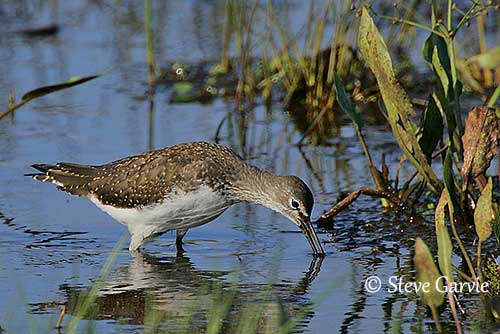

During the breeding season, the Green Sandpiper male performs a typical display flight, rising first on quickly fluttering or vibrating wings. Then, it flies in circles or semicircular pattern before doing a steep dive on fixed wings. It repeats this display several times, accompanied by song. They are monogamous.
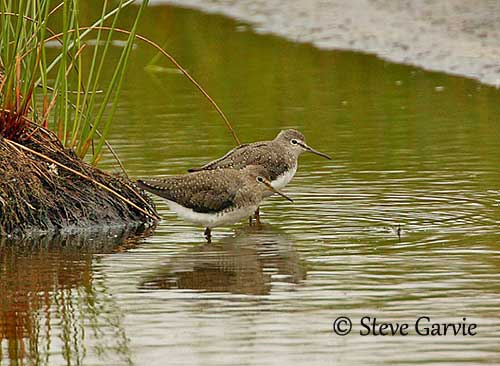
The Green Sandpiper is migratory, flying overland in broad front, spanning full width of West Palearctic. The females often leave first, as early as late May, but most of other birds leave only in July-August. The return migration to N occurs from late February to mid-May. They usually fly in low concentrations.
The Green Sandpiper has rapid flight with deep wingbeats. When flushed, it may zigzag wildly and then tower high in the sky before diving abruptly back to ground. The flight is very snipe-like, with sharp flicks of the wings.
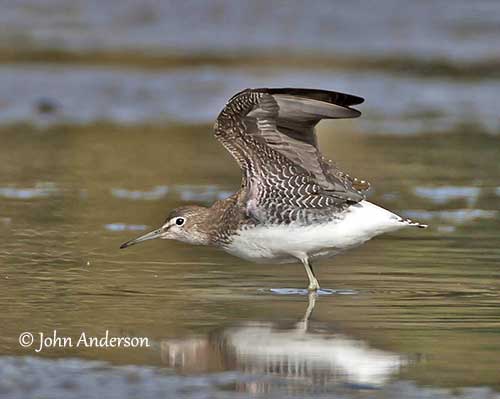
REPRODUCTION OF THIS SPECIES:
The breeding season takes place from late April to July. The Green Sandpiper nests in damp wooded areas, with a density of 1-8 nests/km².
This species does not build a nest, and often uses an old one, abandoned by thrush or Wood Pigeon, or by squirrel. It may also use a natural platform, or may occasionally nest on the ground, in a shallow depression between tree roots.
The female lays 4 (sometimes 2-3) creamy-white to pale olive eggs with brown markings. Both adults incubate during 20-23 days, but the female does most of incubation. At hatching, the chicks have dull grey down with dark markings, and a dark line across and along the crown.
The young have to jump 10 metres or more to the ground to leave the nest, very soon after hatching. The female often leaves before they fledge, about 28 days after hatching. This species produces a single brood per season.
PROTECTION / THREATS / STATUS:
The Green Sandpiper is threatened by habitat changes on the wintering grounds, and by virus of avian influenza.
The global population is estimated to number 1,200,000/3,600,000 individuals (2006). This population appears to be stable or slowly decreasing. But currently, the Green Sandpiper is evaluated as Least Concern.
